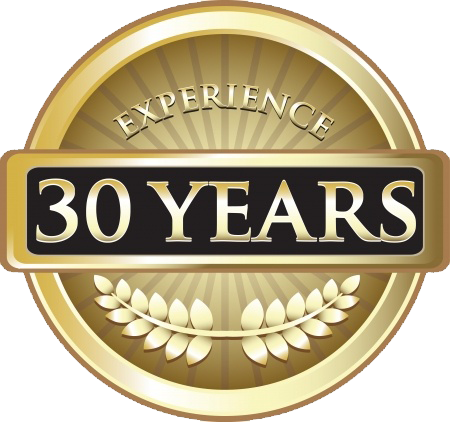-
Welcome!
In pampy's post Jul25b;
🍎 The value of the most accurate non-invasive body scan
🍎 Run forward - not up and down!
🍎 Focus@Will - superboost your concentration with 'your' right music
🍎 Maybe time for a quick desk-stretch
🍎 Beat seasonal sickness with Grandma's super syrup!
🍎 Breaking Bad - the ultimate 7-day listed mini reboot
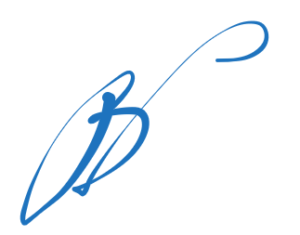
-
Why you should consider a
non-invasive Body Scan!
With biotechnology and bioAI advancing rapidly, the potential for instant health feedback is remarkable. From smartwatches and rings to wrist bio-feedback monitors and temporal sensors, data collection has become non-invasive and available around the clock.
While I believe this data enhances our health awareness, which is beneficial, based on my experimentation, I am not entirely convinced of the accuracy and relevance of results from some devices.
Additionally, I worry that with an overwhelming amount of data (or "data-tainment"), our innate understanding of our health may deteriorate. However, the one...bio-feeback unit I truly rate and base much of my prescription on is the non-invasive Body Pod.
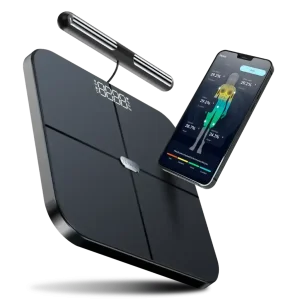
What is the Body Pod?
The Hume Body Pod is a smart scale that delivers detailed body composition analysis, going beyond basic weight measurements to provide insights into fat, muscle, and other metrics. It employs both footpad sensors and a handheld scanner to evaluate body composition, offering a more comprehensive analysis than typical smart scales. My data indicates that it has 98% accuracy compared to a comprehensive $60K DEXA scan unit.
How it works!
Pop off your shoes & socks, stand on the scale while holding the arm paddle, and in 60 seconds, you'll be able to see all your numbers on my 'private' account. I can then confidentially forward your results to you. Or, download the completely FREE app - Apple (CLICK HERE), Google (CLICK HERE).
📲 Because it’s your app, if you choose, only you see the results. The collation of tests over time is most interesting.
The Hume multi-frequency monitors measure bioelectrical impedance at three or six different frequencies. The lower frequencies assess the impedance outside the cell membrane, while the higher frequencies can penetrate the cell membrane. By measuring impedance at both lower and higher frequencies, it can calculate extracellular water (ECW), intracellular water (ICW), and Total Body Water. The algorithms will handle the rest.
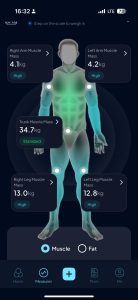
I believe the most relevant of many metrics are;
💪 Lean muscle mass - total muscle weight; and the distribution - see pic
⚖️ Subcutaneous body fat – and the distribution - with the trunk% [around the heart] being most critical for aging males
🦴 Bone mass - is relevant for women, particularly lighter women
💧 Water mass - this can be particularly relevant for those exercising heavily.
(Finally) The Practicality
Case Study One: With Mum now approaching 80 years of age, her naturally decreasing muscle mass and bone density are significant concerns. Her lean muscle mass is essential for her metabolic health and contributes to her functional strength, which supports activities like gardening, shopping, and descending stairs. Additionally, maintaining her bone mass is important for aiding her coordination and balance. Engaging in appropriate resistance exercises can help rejuvenate both her muscles and bones. She wants to know her muscle & bone health.
Case Study Two: Annie, 21 years old, is a full-time athlete who requires muscle size and strength for her power-based sport of water polo. She is seeking to increase her muscle mass. Moreover, her hydration status is critical to her performance. With 25 hours of activity each week, she understands that if her 'body fat' percentage drops too low, her immune system becomes compromised, which is also linked to her iron balance.
Case Study Three: Colin, 54 years old, had a decorated rugby career as a prop, but like many men, he has allowed life to affect his body fat-to-muscle mass ratio. While he is accustomed to carrying a larger frame, he is aware that having excess body fat around his heart (chest) can be potentially risky. He wants to understand his body fat percentage in that specific region. He also knows excessive body fat will significantly increase his functional aches & pains.
For more on the pod - CLICK HERE
I include the pod in my 30-minute non-invasive (pain-free) private & confidential executive health assessment (please feel comfortable popping in) - CLICK HERE
-
Run forward, not up & down!
The action of running—whether it's shuffling, jogging, running, or sprinting—involves intermittent contact with the ground, which serves as our base of support (BOS). Unfortunately, this contact creates a braking effect that slows down our forward momentum. The goal is to reduce these braking forces to minimise impact on our body parts, such as the ankles, knees, hips, and back, while also improving our speed.
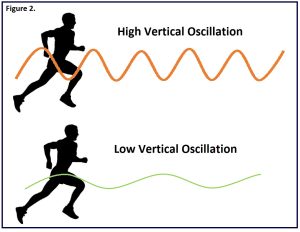
One effective way to lower the contact forces - and reduce potential injury & slower running pace - is to limit the height from which we fall, which means minimising vertical oscillation. Generally, the less vertical movement, the better. Vertical oscillation usually increases when a runner overstrides—landing and loading the foot ahead of the hip (centre of mass, or COM) before pushing off the ground and extending the knee joint.
Think wheel, not square!
When a wheel rolls over an even surface, its centre of mass (COM) experiences zero vertical oscillation. This means that, unless you're coming from a height, the hub (COM) should encounter minimal stress. The wheel, with its momentum and a slight gradient>, simply rolls over itself from this stress.
When I run, I visualise myself as if I am inside a wheel, aiming to minimise my vertical oscillation. I achieve this by striding at a rate of 176 strides per minute and keeping my gaze fixed on a point 50 meters ahead. I focus on cushioning the impact of my foot strike using the hinge of my ankle and knee joints.
The tennis ball test (see below)
Wearing a tennis ball necklace, the goal is to run with as little tennis ball bounce as possible.
🏃♂️➡️ PIC 1 (Speed: 14kph) – I am deliberately overstriding, pushing off and crashing my contact.
🏃♂️➡️ PIC 2 (Speed: 14kph) - I am running with my right cadence and cushioning and recoiling my foot strike.
📈 I’m also recording the sound waves of my contact. The lower the sound waves (less oscillation & spikes), usually, the better.
-
Focus@Will – supercharging your brain with

The following article may help those who need to focus, especially on complex tasks, as it’s easy to get distracted at times.
The world of music therapy utilises music to alter brainwaves and influence cognition, which includes emotions, focus, and memory. A positive change can lead to better overall health.
In my professional week, there are moments when I need to focus creatively for extended periods. This might involve prescribing an exercise and dietary plan or writing a thought-provoking health-related article. During these times, I prefer not to talk to anyone; the more I can centre my thoughts, the better my work becomes. Achieving the right prescription or health advice typically requires a deep focus on the task at hand. Any interruption or distraction can derail the flow of thoughts.
I enjoy music, so I use the right kind of music to help maintain my focus. For several years, I have used the website/app – Focus@Will – to find and play 'my' best sounds when I need to concentrate.
Focus@Will was created by accomplished musician Will Henshall, who, for those who grew up in the '90s, was the leader (and writer) of an electronic band called Londonbeat. While this genre was not my cup of tea at the time, Londonbeat certainly energised dance floors worldwide, particularly with their biggest hit, "I’ve Been Thinking About You."
When Nirvana and Pearl Jam emerged, Will had to find a new career.
Teaming up with world-leading neuroscientists and psychologists, Will Henshall and the team studied various types of music that enhance focus and improve productivity.
How it works: You begin by answering a short personal questionnaire. Shortly after, the recommended type of music for maintaining ‘your’ focus is provided. It’s clear everyone responds best to different music. Simply throw on some headphones, press play, and get to work. Data shows that most people get distracted within 20 minutes, whereas Will’s tunes can help you stay undistracted (and creative) for up to 3 hours. He recommends taking a 20-minute break before pressing play again and returning to work. The music has “no (distracting) lyrics” and spans various genres, but the sounds are specifically tailored to stimulate ‘your’ prefrontal cortex and help you concentrate on your task.
This approach definitely works for me! When I need focused, limitless concentration, I grab the BOSE and press play.
Focus@ Will (7 day FREE trial) – CLICK HERE
-
Beat those seasonal bugs
with Grandma's Super Syrup!
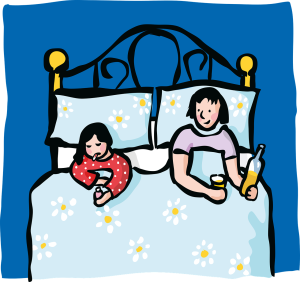
It’s that time of year again when sniffles and lower respiratory ailments can rip through your home and workplace.
fyi...
Here’s a trusty (and well-practised) remedy my Grandma passed down to relieve discomfort and speed up recovery.
It’s all-natural, cheap, easy to prepare, and, for me, it really works!
* Slice up an onion and stuff it into a jar.
* Pour the most natural ‘darkest’ honey you can find to the brim.
* Let it sit for 12 hours.
The honey ferments and draws out the onion’s anti-inflammatory and antibiotic compounds
– like allicin, nature's lung & throat protector.
* Drain the syrup into a clean jar.
* Use the syrup at the first signs of a flu, cough, or sore throat.
👵 On bouncing back quickly, be sure to thank my Grandma 👵
......................................................................................................................................
-

Do you feel a tad flat, in a hole with little mojo towards activity – certainly exercise – munching on ‘sometimes food’ more and more and waking with little spark! Well, unfortunately, this is normal – hello humans.
Winter, typically, amplifies this feeling and behaviour.
If you’re in a rut and you just need a one-week guided (and safe) booster, he’s a listed movement, nourishing & sleeping guide to rejuvenate your winter mojo.
